
Although there was an experimental official airmail flight to the United States in 1938, a regular New Zealand - USA airmail service did not start until 1940. However, mail from New Zealand could connect with airmail services provided by other countries, including the USA and Canada.
Before July 1930, the air mail surcharge had to be paid in the stamps of the country providing the airmail service while, from 1 July 1930, the cost was prepaid in New Zealand stamps.
Mixed Franking for US Airmail pre July 1930
Cook Islands to USA, 1928
Before July 1930, letters had to have a mixed franking of stamps: the airmail surcharge was paid in the stamps of the country providing the airmail service, while the surface rate was in the stamps of the country where the mail originated.
An example is the following cover from the Cook Islands to the USA in 1928. At that time, New Zealand stamps were not accepted for payment of the airmail surcharge in the USA.

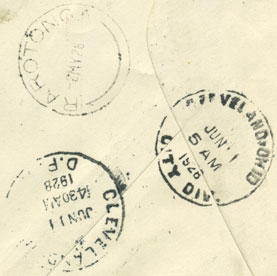
This cover is addressed to Cleveland, Ohio and was sent from Rarotonga (Cook Islands), a New Zealand Dependency. It is franked with a New Zealand George V 3d overprinted Rarotonga together with a US 10c airmail stamp.
The 3d stamp was postmarked in Rarotonga on 2 May 1928 while the US stamp was postmarked in San Francisco on 8 June. There are two Cleveland backstamps of 11 June and it was presumably flown there from San Francisco by US air services. The Union Steam Ship Company had a regular Sydney - Wellington - Rarotonga - Papeete - San Francisco service. The Makura left Wellington on 22 May and was in Rarotonga on 26 May and arrived in San Francisco on 8 June [10].
I have seen a cover from Samoa to the same address that was postmarked in Apia, Samoa on 15 May 1928 with a 10c US stamp postmarked in San Francisco on 1 June. It therefore seems that someone, armed with US airmail stamps, was touring the Pacific and sent covers to be flown on US airmail from the different islands he visited.
The US domestic airmail rate had been set at 10c (8c air mail + 2c surface) on 1 February 1927 and from 1 June 1927 that was also the airmail surcharge for mail from abroad. On 1 February 1928, the airmail surcharge for mail from abroad was reduced to 8c - it seems that the overseas surface postage was now contributing to the required postage and so the cover is overfranked by 2c.
However, it seems likely that the news of the change would take some time to get to Rarotonga and anyway
the sender was using up his stock of 10c airmail stamps and not be particularly bothered about the cover being overfranked.
New Zealand to New York in 1929

This letter from New Zealand to New York is postmarked in Auckland on 23 December 1929.
It has a mixed franking of a 1d New Zealand plus 5c in US stamps.
On 1 August 1928, the domestic US airmail rate was reduced to 5c while the airmail surcharge for mail from abroad was reduced to 4c [1] and so the cover is overpaid by 1c.
However, the sender no doubt believed that the full domestic US rate was required. (All the examples of incoming air mail at this time shown in [1] are also franked with 5c.) It is interesting to note that both the New Zealand and the US stamps are postmarked in Auckland. In the previous example, the US stamp was not postmarked until arrival in the US.
This cover was carried on the Tahiti that left Wellington on 31 December and arrived in San Francisco on 17 January [10] and flown from there. The US term for this was to accelerate mail delivery.
As you might expect, it was a far from simple process to determine the required foreign rate and to acquire the necessary foreign postage stamps. Such mixed frankings are therefore unusual and explains the errors in the above frankings as overseas postal clerks would be unlikely to have all the up to date information on foreign countries.
That arrangement could not continue if international air mail was to become commonplace and so, at the Universal Postal Union Convention held in London in 1929 an international agreement was reached that prepayment could be made in the stamps of country from which the letter orginated. This came into force on 1 July 1930.
I have been able to find few other examples of 1920s mixed franking airmails from New Zealand and have written an article describing the ones shown here [2]. The other examples are a cover postmarked 14 April, 1926 and addressed to Michigan that is franked with 18c in US stamps and one postmarked in May 1926 and addressed to New York that is franked with 24c in US stamps.
Crewe shows a 1925 cover with mixed franking from Hong Kong flown by internal US
mail services [4] and an article by Legg describes such mail from Australia [6].
Air Mail from USA and Canada 1926 - 1930
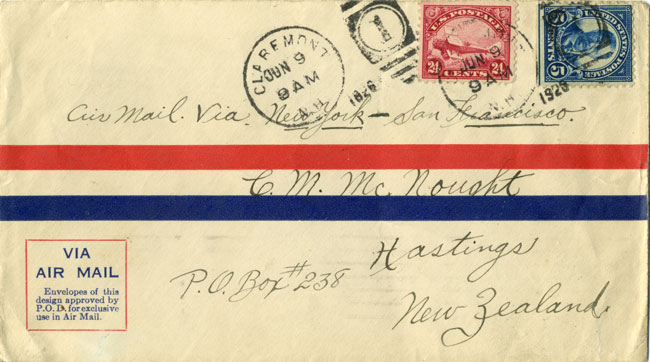
1926
Mail could be flown internally in the USA and then sent by sea to New Zealand from San Francisco.

This 1926 cover addressed to Hastings in New Zealand is postmarked on 9 June 1926 in Claremont, New Hampshire, and has a San Francisco transit mark on 11 June and Air Mail via New York - San Francisco in manuscript. It is franked with 29c.
US air mail rates in 1926 were very complicated as mail could be flown over a combination of different government zones and Contract Air Mail (CAM) routes and I would like to thank Bob Watson for his help in the following.
The domestic US surface rate was 2c which was the same as the overseas rate to New Zealand because of special treaty arrangements. For non-treaty countries the surface rate was 5c [15].
The air mail rate was 6c per oz for one government zone (plus 2c surface rate) and 8c per oz for each subsequent zone. New York to San Francisco involved three government zones giving a total air mail charge of 24c. (An alternative explanation is that it was flown on the CAM route from Boston to New York which was 10c plus 5c for each government zone giving a total of 25c [15].) In both explanations, the cover is overfranked.
Covers at that time sent by US air mail followed by surface to overseas destinations are uncommon and postal clerks would not be used to dealing with them. A possible explanation is that the cover is correctly franked with 24c and then a further 5c was wrongly added to cover the surface rate to a foreign country.
The Makura sailed from San Francisco to Wellington on 16 June - 5 July 1926 and would
have carried this cover.

1927

The next cover is addressed to New Zealand and is postmarked at 4.30pm on 25 August 1927 in Portland, Oregon. There is a San Francisco backstamp the next day at 2.30pm on 26 August and a Via Air Mail cachet in purple.
Portland to San Francisco was part of air mail route CAM 8 which was from Seattle to Los Angeles and had been operated by Pacific Air Transport since September 1926.
There was a major simplification of air mail charges on 1 February 1927 and the air mail charge was now 8c per ½ oz [15] to which had to be added the 2c surface fee to New Zealand. It is therefore correctly franked with 10c.
The Makura sailed from San Francisco to Wellington on 7 - 26 September 1927 and may
have carried this cover.
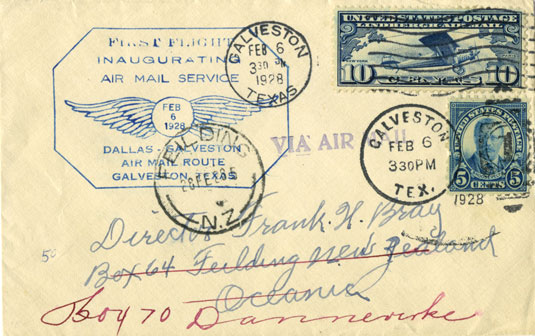
1928
This cover was sent on the first flight from Galveston, Texas to Dallas on 6 February 1928 and is addressed to Fielding in New Zealand. It is franked with 15c while only 10c was necessary.
The sender may have wrongly believed that the required franking was 10c for domestic air mail (8c + 2c) plus 5c for overseas non-treaty surface mail (5c) giving a total of 15c.
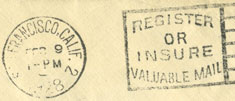
It has a San Francisco transit mark on 9 February and a Fielding postmark on 28 February due to it being re-directed to Dannevirke.
I have been unable to find a direct trans Pacific sailing that fits these dates
although Bob Watson tells me that the Ventura sailed from San Francisco to Honolulu on 9 - 15 February
and the Niagara from Honolulu to Auckland on 15 -27 February.
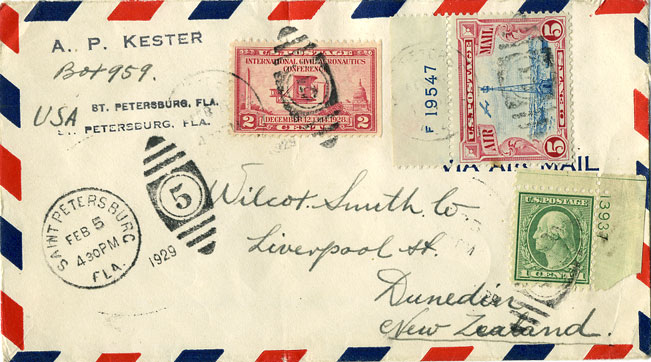
1929
This cover is postmarked in St Petersburg, Florida on 5 February 1929 and addressed to Dunedin, but there are no transit marks. It is franked with 8c and both the 1c and the 5c stamps have plate control numbers in the margin.
On 1 August 1928, the inclusive domestic airmail rate was reduced to 5c while the rate for air mail addressed abroad was reduced to 4c airmail surcharge plus the surface rate [1, 15]. Hence, as the required postage was now 6c, the cover is overpaid by 2c.
A possible explanation for the wrong franking is that it is the 5c US domestic air mail rate to which has been added 3c
to cover the overseas surface rate of 5c minus the US domestic rate of 2c.

1930

This cover was flown on the first regular flight from Medicine Hat, Alberta to Regina in Saskatchewan by the Prairie Air Mail service of Western Canada Airways.
It was postmarked in Medicine Hat at 2 am on 3 March, 1930 and then backstamped at 8 am in Regina. This was part of a new airmail service between Calgary and Winnipeg. The route was Calgary - Medicine Hat - Moose Jaw - Regina - Winnipeg and was the first regular night airmail service in Canada.
The cover was then sent from Canada to New Zealand by sea,
presumably from Vancouver although, if that was the case, the airmail flight was
actually in the wrong direction.
Antarctica to New Zealand, 1930

Cover carried on one of the Antarctic flights from Little America, the base of the First Antarctic Expedition of Richard Byrd (October 1928 - February 1930). Likely flown in late 1929 or early 1930.
Addressed to Dunedin. Most such cobvers are addressed to America.
No Post Office in Little America at that time which is why covers were not postmarked until 19 February on S.S. City of New York which carried members of the Expedition to Dunedin (arriving 10 March) when the expedition ended.
The expedition members also performed the first flight over the South Pole on 29 November 1929.
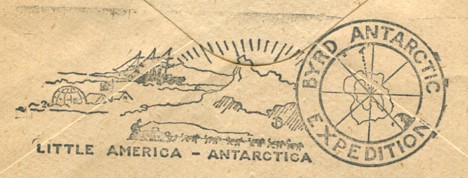
.
The cover has a logo on back with inscription Little America - Antarctica which was applied to flown covers.
Covers flown on the South Pole flight have the same logo, but with the inscription South Pole Air Mail.
Prepayment in New Zealand Stamps now allowed, July 1930
Mail prepaid in New Zealand stamps was first accepted for US and Canadian airmail services in July 1930. The air mail fee was 4d per ½ oz and so the total rate was 5d for the first ½ oz including 1d surface rate per oz. Mail was also accepted at that time on the Karachi - London and Adelaide - Perth airmail routes.
First acceptance to North America was via San Francisco
Mail steamers from New Zealand left once a fortnight for either San Francisco or Vancouver. The first mail to use either US or Canadian airmail services with the cost prepaid in New Zealand stamps left Wellington for San Francisco on the S.S. Makura on 15 July 1930. A total of only 48 items was sent to all destinations.
First acceptance to USA, July 1930

This cover is postmarked in Timaru on the earliest possible date, i.e. 1 July, and is addressed to New Jersey It is franked with 5d made up of 4d airmail fee plus 1d surface postage.
The trans-Pacific service was fortnightly and the next mail ship did not leave New Zealand until 15 July.
On arrival in San Francisco on 1 August, mail that was then to be flown was sent by ferry across San Francisco Bay to Oakland Airport. The purple cachet Ferry Station was applied to this mail.
This cover would be flown by Boeing Air Transport on route CAM 18 from San Francisco to
Chicago and from there by National Air Transport on route CAM 17 to New York.
First acceptance to Canada, July 1930
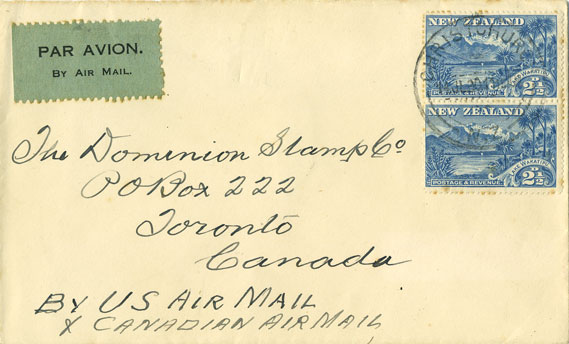
This cover is postmarked on 14 July in Christchurch and is addressed to Toronto and so was flown on both US and Canadian airmail services. It is franked with 5d made up of 4d airmail fee plus 1d surface postage.

It left Wellington on the S.S. Makura on 15 July 1930 and on arrival in San Francisco on 1 August, it was sent by ferry across San Francisco Bay to Oakland Airport. as shown by a purple Ferry Station cachet.
It was then flown by Boeing Air Transport on route CAM 18 from San Francisco to
Chicago and from there by National Air Transport to Detroit and from
there by Canadian Airways to Toronto where it was
backstamped on 4 August.
Second acceptance to North America was via Vancouver
To UK via Vancouver, July 1930
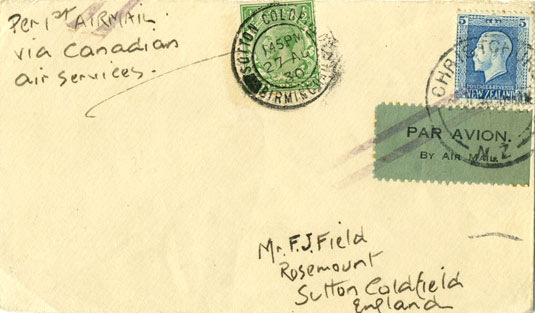
The first acceptance via Vancouver left Auckland a fortnight later on 29 July on the S.S. Niagara which arrived in Vancouver on 15 August.
This cover is postmarked in Christchurch on 26 July 1930 and is addressed to the UK with the routing via Canadian Air Services. However, it should be noted that both the air mail label and the manuscript have been crossed out by two parallel purple lines. This jusqu'a cancellation was applied after the last air mail leg to indicate that the rest of the journey was by surface mail. According to [11] the purple parallel line handstamp was applied in New York.
The cover left New Zealand for Vancouver on 29 July. If it then went by Canadian Air Services, the route would have been: rail to Calgary, then by air on the route: Calgary - Lethbridge - Medicine Hat - Moose Jaw - Regina - Winnipeg., then to Pembina in the USA and from there to Chicago by CAM Route 9 and on to New York.
However, despite the routing instructions, the likely route is that it was put off the ship at Victoria on Vancouver Island and flown by seaplane to Seattle before being flown by US air services to New York. That was the route for air mail to US destinations.
The cover had arrived in Sutton Coldfield by 27 August. After receiving a cover, it was Francis Field's practice to affix a ½d stamp and take the cover to his local post office and get it postmarked to prove the arrival date. A similar cover to Sutton Coldfield is shown in Walker [5].
Later flight: To UK via Canadian airmail, December 1930
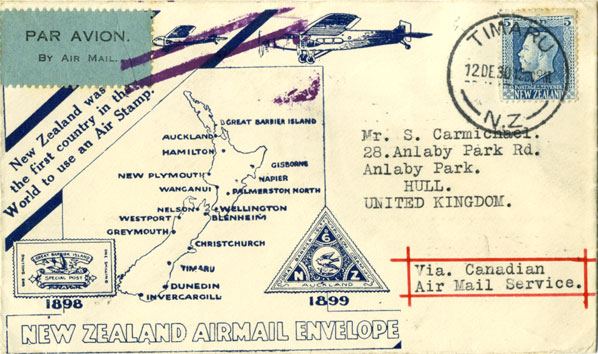
This next cover was also sent to the UK via the Canadian Air Mail service and is postmarked in Timaru on 12 December, 1930.
It would have been sent from Auckland to Vancouver on the RMS Aorangi which left on 16 December [10] and arrived in Vancouver on 2 January.
Again, the air mail label has been crossed out to indicate that the trans-Atlantic leg was by sea. The jusqu'a cancellation was applied in New York and so the cover travelled on the same route to Seattle and then on US air services as the previous cover.
It is from Alex Paterson and looks highly philatelic, but I am not aware of
there being anything special about the date.
Increase in Postal Rates, 1 March 1931 & 4 June 1931
On Sunday 1 March 1931, the New Zealand surface postal rate to Empire countries and USA was raised to 2d for the first ounce and 1d for each additional oz while previously they had been 1d per ounce [10]. That meant that the combined air mail rate to Empire countries and USA was now 6d for the first ½ oz. The overseas surface postal rate for non-Empire countries remained at 2½d for the first oz and 1½d for each additional oz.
On 4 June 1931, the air mail fee to the UK, Europe and Canada via US air services was increased to 5d per ½ oz [10,14] and so the combined air mail rate to Empire countries was now 7d for the first ½ oz including 2d ordinary postage. The air mail fee to the USA remained at 4d per ½ oz as did the air mail fee to Canada when US air mail services were not used giving a combined rate of 6d for the first ½ oz [14].
Use of New Zealand airmail stamps, November 1931
The first New Zealand airmail stamps were issued on 10 November 1931 and the first acceptances for airmail flights in North America left Auckland on the SS Aorangi on 17 November and arrived in Vancouver on 4 December.

To UK
Although this cover has the routing instructions Via Canada, it would have been landed at Victoria (in British Columbia) and flown from there to Seattle where it would enter the US Air Mail network. Mail for the eastern US would have been flown to Salt Lake City and from there on CAM Route 18 to Chicago.
The cover is addressed to the UK. Both the air mail etiquette and the routing instructions via Canada have been crossed out with a single pair of parallel purple lines which would have been applied when the air mail part of the journey was over. According to Walker [5], this termination cachet was applied in an identical fashion to mail for the UK that had been routed by US Air Mail Services or by Canadian Air Mail Services. He therefore suggests that both groups were sent by sea from New York with, in both cases, the final part of their North American flight being Chicago - New York. That fits with the information given in [11].
It is correctly franked with 7d (2d ordinary postage
plus 5d air mail within United States).
After delivery to Francis Field, a ½d stamp was added to the cover and he took the cover to
his local post office to get an arrival datestamp
which is 18 December 1931.
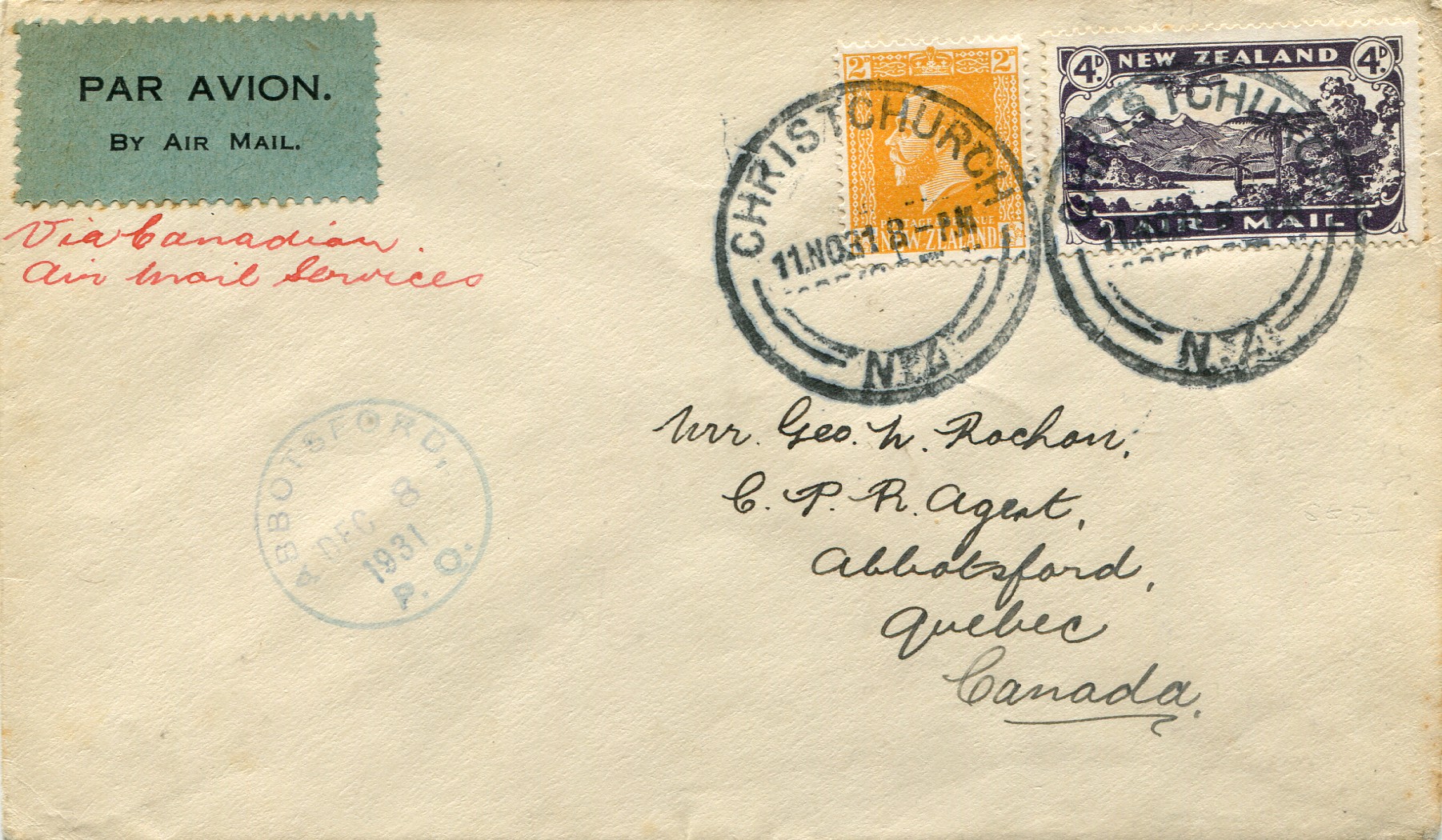
To Canada
The next cover is addressed to Abbotsford, Quebec and is franked with 6d (2d ordinary postage plus 4d air mail within Canada).
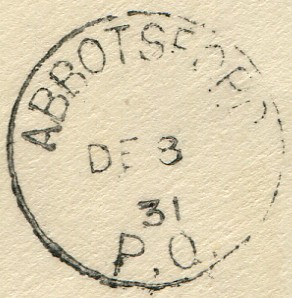
After arriving in Vancouver on 4th December, it was sent by rail to Calgary and flown from there on the route: Calgary - Lethbridge - Medicine Hat - Moose Jaw - Regina - Winnipeg by Western Canada Airways. From Winnipeg, the mail was sent to Quebec by rail and has an Abbotsford arrival stamp on 8th December.
If the ship had arrived in San Francisco, the required franking would have been 7d to pay for US air mail services [14].
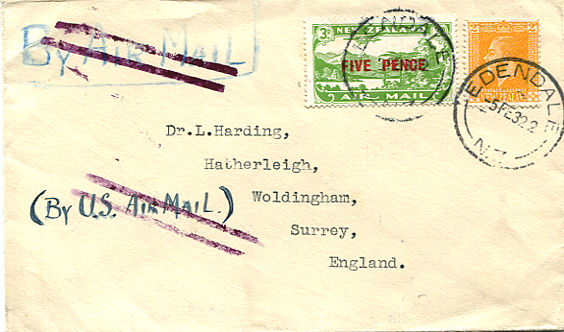
To UK Feb, 1932
This cover to the UK is postmarked on 5 February 1932. The By Air Mail instructions have been crossed out by parallel purple lines that were applied in New York to indicate that the rest of the route would be by surface.
It does not have a Ferry Station cachet as the next sailing was the Niagara which left Auckland on 9 February and arrived in Vancouver on 26 February.
Mail sent to Vancouver entered the US postal system at Seattle and was off-loaded at Victoria on Vancouver Island before it got to Vancouver. The service from Victoria on Vancouver Island to Seattle was "all up", i.e. all letters were sent by air mail.
Like the previous cover, it is correctly franked with 7d.
Reduction in Rates, 1 June 1932
On 1 June 1932, the surface rate was reduced back to 1d per oz and so the combined air mail rate to the UK via USA became 6d for the first ½ ounce while the combined air mail rate to the USA (and to Canada when US air services were not used) became 5d for the first ½ ounce.
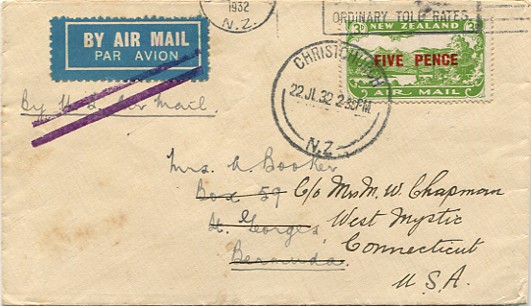
To Bermuda, July 1932
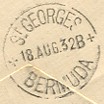
This air mail cover is postmarked in Christchurch on 22 July 1932 and is addressed to St. Georges in Bermuda. The air mail etiquette has been cancelled in New York as the final leg to Bermuda was by sea. An interesting point is that it is franked with 5d which suggests that the rate to Bermuda was the same as the rate to USA. After arrival in Bermuda it was redirected to the USA and is backstamped in St Georges on 18 August.
The next sailing to North America was the Niagara which sailed from Auckland to Vancouver on 26 July - 12 August
which explains the lack of a Ferry Station backstamp.
As with the previous cover, it would enter the US postal system at Seattle.
Registered cover to Germany, 1933
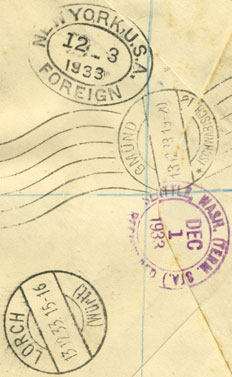
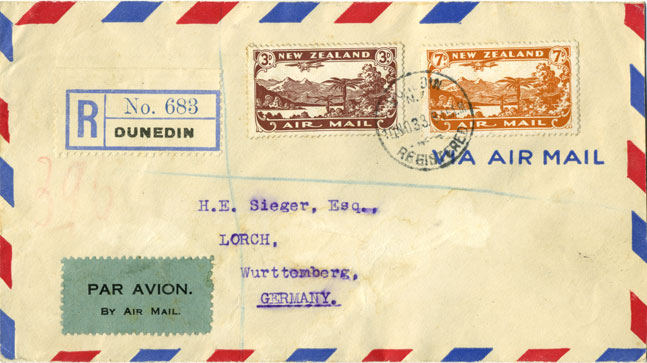
This registered airmail to Germany contains no routing instructions, but has both Seattle and New York backstamps indicating that it entered the US postal system at Seattle and left it in New York.
It is postmarked Dunedin on 10 November, 1933 and was carried on the SS Aorangi which sailed from Auckland to Vancouver on 14 November - 1 December [10]. It would be offloaded in Victoria (Vancouver Island) and flown to Seattle (backstamped December 1) before being flown to New York (backstamped December 3). It was carried by sea to Europe where it was backstamped in Germany on December 13 and so was 34 days in transit.
Although it has no routing instructions, it is franked with 10d which includes 3d registration fee leaving 7d for the American airmail fee plus surface to Germany which I believe means that it was underfranked by ½d. It would have been sent via the USA as it does not have sufficient franking for the Karachi - London service where the airmail fee was 7d plus 2½d surface to Germany.
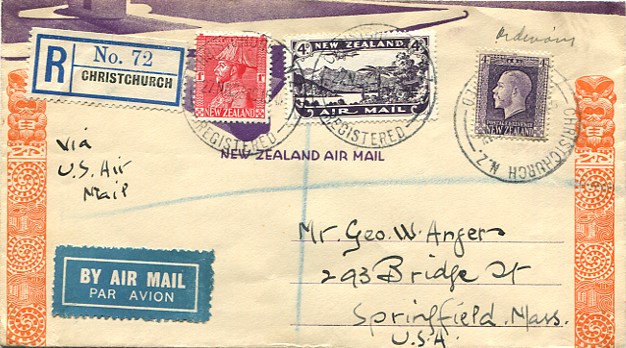
Registered to USA, November 1933
This registered cover is postmarked at 10.15 a.m. in Christchurch on 27 November 1933 and is addressed to the USA. It is backstamped in San Francisco on 15 December and again in Springfield, Massachusetts on 18 December.
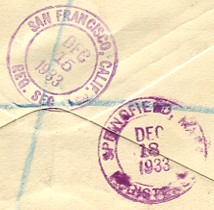
It is franked with 9d and so it appears to be over-franked by 1d as the airmail rate to be flown in the USA was 5d and the registration fee was 3d.
Mail for the Makura closed in Christchurch at 5.25 p.m. on 27 November.
The Makura sailed from Wellington on 28 November and arrived in
San Francisco on 15 December and so the dates fit exactly.
There is no Ferry Station cachet.
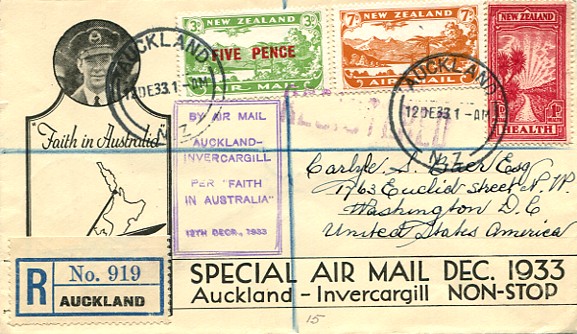
To Invercargill, December 1933
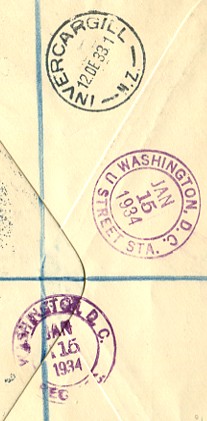
This registered cover was flown by Ulm and Allan on the special flight from Auckland to Invercargill on 12 December 1933. It is franked with 1s 1d and is addressed to Washington D.C. where it was backstamped on 15 January 1934.
The airmail rate for the flight to Invercargill was 3d in addition to 1d surface rate. The additional rate to be flown on USA airmail services was 4d and the registration rate was 3d which gives a total of 11d.
Likely sent from Wellington on 27 December on the SS Maunganui which arrived in San Francisco on 13 January 1934.
That fits with the Washington D.C. backstamp.
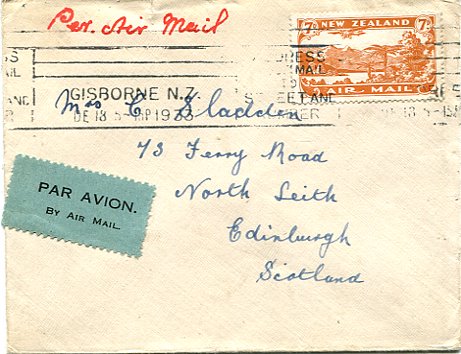
To Scotland, December 1933
This cover is postmarked in Gisborne on 18th December 1933 and is addressed to Edinburgh. It has no routing instructions and is franked with 7d which is 1d less than the rate via the Karachi - London service.
There is a Ferry Station cachet on the back which was applied in San Francisco to mail that was sent by ferry across San Francisco Bay to Oakland Airport. This proves that it was sent via the USA and flown by internal US mail services. The next sailing was on 27 December from Wellington on SS Maunganui [10] arriving in San Francisco on 13 January 1934. New Zealand - US and US - UK was by sea.
It is not clear that this was the intention of the sender as the
postage rate via US air mail was 6d.
Likely it was intended for the Karachi - London service, but not sent on that route as it
did not have sufficient franking.
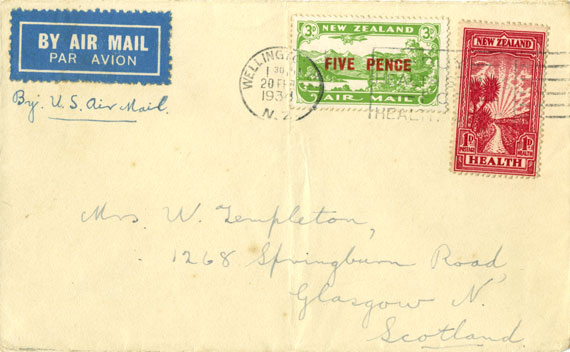
To Scotland, 1934
Mail could be explicitly routed via USA. This cover to Glasgow has the instruction By U.S. Air Mail. It is postmarked Wellington at 1.30 pm on 20 February 1934, only a few days after the first trans-Tasman flight to Australia. The mail for the SS Maunganui closed in Wellington at 2pm on 20 February and arrived in San Francisco on 9 March [10].
A note on the back states that it arrived at 9a.m. in Glasgow on 22 March and so was 30 days in transit. There is no backstamp. Sending it by air in USA did not speed up the journey as the ordinary mail sent on the SS Maunganui arrived in London on 21 March [10].
It is franked with 6d (1d surface plus 5d air mail fee to UK via US air mail services [13]).
A cover also with 6d franking and postmarked in Dunedin on 5 October 1934
is described by Shelton [7].
It had no routing instructions and had the added cachet
Paid for United States Airmail Service Only on two lines in purple.
There was some correspondence on this topic with the consensus being that it was
applied in New Zealand as airmail was supposed to be correctly routed via
Karachi or USA [8].
As Shelton's cover had insufficient postage for the Karachi service, it must
have been intended for US airmail.
As far as I am aware, no other cover with that cachet has been reported.
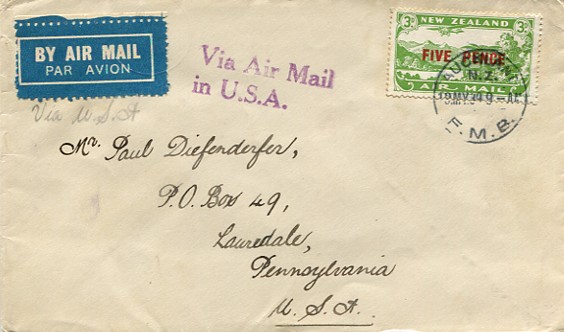
To USA, May 1934 (1)
We now have two covers postmarked with two days of each other.
Cover to Pennsylvania postmarked in Auckland on 19 May 1934 and correctly franked with 5d (1d surface plus 4d air mail fee for US inland air services [13]). It has the cachet Via Air Mail in U.S.A. on two lines in purple which I assume was applied in Auckland.
The next sailing was to Vancouver on the Niagara on 29 May - 15 June
and so the cover would enter the US postal system at Seattle.
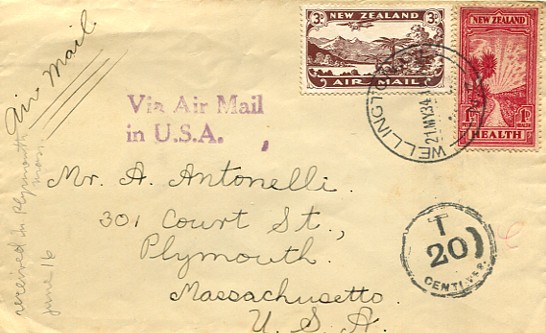
To USA, May 1934 (2)
The second cover is to Plymouth, Massachusetts, is postmarked in Wellington on 21 May 1934 and has the same Via Air Mail in U.S.A. cachet as the first cover.
It is only franked with 4d and so has a postage due charge of 20 centimes. One of the stamps is the 1933 Health stamp. Perhaps the sender thought that the Health surcharge of 1d would count towards the postage.
It would also be sent from Auckland on the Niagara on 29 May - 15 June
and enter the US postal system at Seattle.
It has received in Plymouth, Mass, June 16 in manuscript on the front
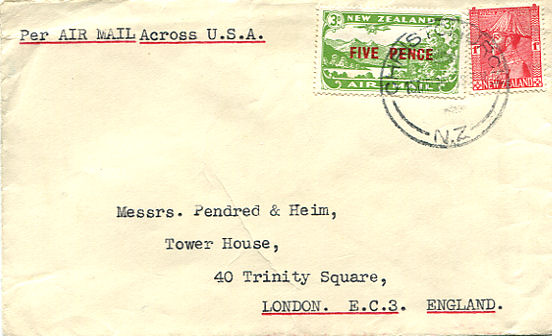
To London, March 1935
This cover to London is postmarked on 15 March 1935 in Christchurch, franked with 6d and routed for Air Mail Across U.S.A.. Two months later, the postage rate was increased to 8d.
The next sailing was the Maunganui from Wellington on 19 March, arriving in San Francisco on 5 April.
Interesting to note that this cover was posted after the Australia - UK air mail service
had started.
Although much faster, it also cost three times as much.
Packet Boat
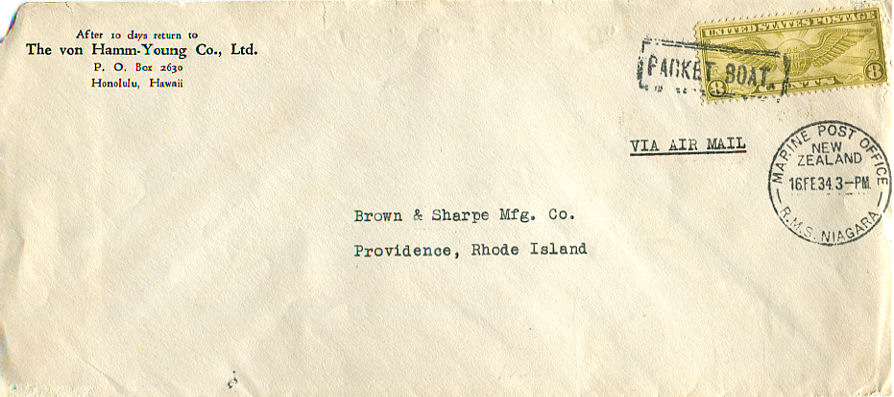
This cover is postmarked on 16 February 1934 at the New Zealand Marine Post Office on the Niagara. It is franked with an 8c US stamp cancelled Packet Boat.
Th Niagara had left Auckland on 5 February and subsequently left Honolulu on 16 February and arrived in Vancouver on 23 February. This cover would be carried from Honolulu to Vancouver and then flown to destination, likely entering the US air mail system in Seattle.
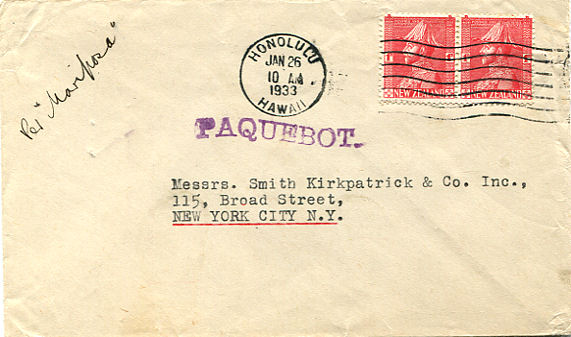
Paquebot
As a comparison, this cover was sent the year before on the Mariposa which was an American ship unlike the Niagara. The cover is franked with New Zealand stamps and postmarked at Honolulu on 26 January and has a Paquebot handstamp.
The Mariposa had left Auckland on 17 January, was in Honolulu on 26 January and arrived in Los Angeles on 31 January and San Francisco on 1 February.
Likely that the cover was posted at sea and then off-loaded on arrival
in Honolulu where it was postmarked by US postal officials.
It is not clear whether it was dealt with in time by the US postal officials
for it to be put back on board the Mariposa to continue its journey to America.
Increase in Rates, 16 May 1935
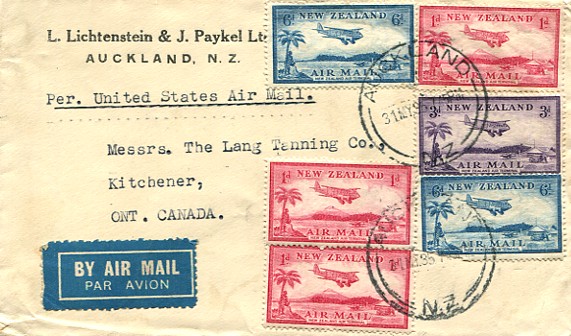
To Canada, flown in USA, 1935
From 16 May 1935, an inclusive air mail rate to the USA was introduced and the rate was now 8d per ½ oz while the inclusive rate to the UK or Canada via US air mail services was now 9d per ½ oz [13].
This cover is postmarked in Auckland on 31 May 1935 and is addressed to Canada with the routing instructions Per. United States Air Mail. It is franked with 1s 6d and so it is franked for a double weight cover.
The next sailing was on the Monterey which left Auckland on 1 June and
arrived in Los Angeles on 15 June.
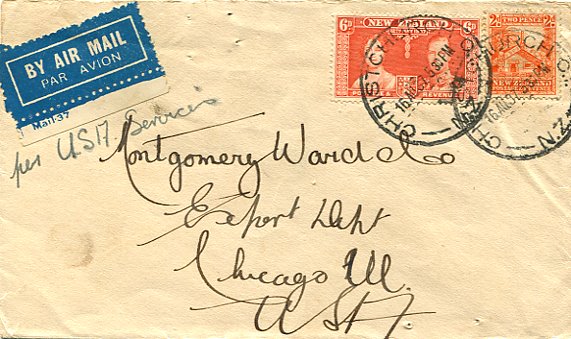
Flown in USA, 1937
From 16 May 1935, an inclusive air mail rate to the USA was introduced and the rate was now 8d per ½ oz while the inclusive rate to the UK or Canada via US air mail services was now 9d per ½ oz [13].
This cover is correctly franked with 8d, postmarked in Christchurch on 16 August 1937 and is addressed to Chicago. It has per U.S.A. Services in manuscript under the Air Mail etiquette.
It would be sent to San Pedro (Los Angeles) on the SS Monterey which
left Auckland on 23 August and arrived on 7 September [10] and then flown.
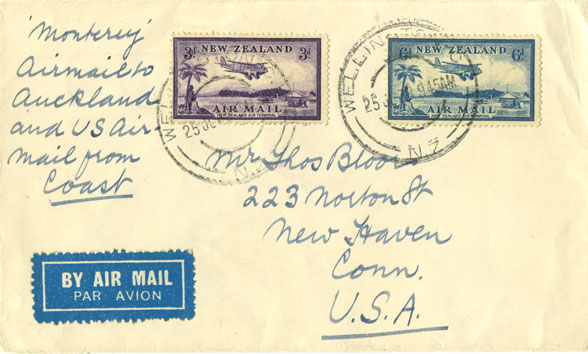
Flown in NZ and in USA, 1938
This cover to the USA was flown from Wellington to Auckland on 25 June 1938, was sent by sea to USA and was then flown by US air mail services. It has the inscription: 'Monterey' Airmail to Auckland and US Air-Mail from coast.
It is franked with 9d. The additional rate for internal New Zealand airmail was 1d in addition to 8d for the US air mail rate.
The next trans Pacific sailing was the Mariposa (not the Monterey) which left Auckland on 27 June and arrived in San Pedro on 11 July and San Francisco on 12 July.
With the inauguration of the direct Australia - UK airmail service in December 1934,the US route was little used for UK or European mail from 1935 to 1940 when the regular New Zealand to USA airmail service started. From 26 July 1938 until the start of WW2, there was no air mail service to the UK via USA air services as all mail to UK went by the Empire Air Mail Scheme.
At the present day, most mail between New Zealand and the UK is routed
via the USA.
Increase in Rates, October and December 1939
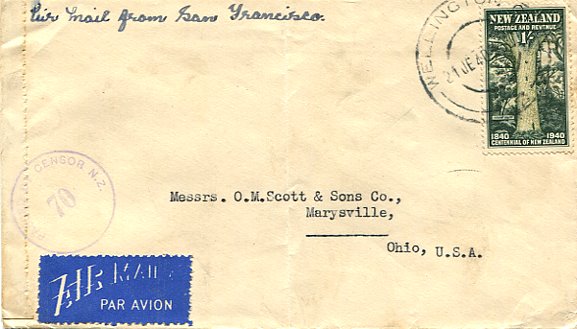
Sea to USA, air within: 1940
This cover is postmarked in Wellington on 21 June 1940 and is franked with 1s. According to Startup [13], the airmail rate per ½ oz for mail from New Zealandby sea to USA, air within this was increased to 10d on 1 October 1939 and further increased to 1s 0d on 1 December 1939.
The cover has appropriate routing instructions: Air Mail from San Francisco. From 17 May 1937, mail could also be sent from New Zealand to Honolulu by sea and flown from there at a rate of 1s 6d. This was increased to 1s 9d on 1 December 1939.
Mail via Australia: Rates, October and December 1939 and April 1940
Mail could also be sent by air via Australia to UK and then trans-Atlantic by sea at a rate of 1s 9d and a cover sent in June 1939 is shown. If this mail was flown trans-Atlantic the rate was 3s 6d.
Once the trans-Tasman air mail started the rate for New Zealand to UK and then
trans-Atlantic by sea was 2s 3d.
The rate when also flown trans-Atlantic was 4s 0d.
This mail was off-loaded from the BOAC service in Marseilles and flown by Air France from there to Lisbon to
connect with the Pan American transAtlantic service.
That route was no longer useful after June 1940 as the air mail
route through the Mediterranean closed when Italy entered WW2.
All scans were made by the author.
[1] Helbock RW, With a Little Help from Our Friends, Part 2,
La Posta: A Journal of American Postal History, vol. 38, pp. 53-64, 2007.
[2] Clark R, Early Airmail to the United States with
Mixed Franking, The Kiwi, vol 57, pp 60-62, May 2008.
[3] Beith R, The St. Lawrence Seaway Air Mail Service 1927 to 1939,
Air Mail News, vol 51, pp 29-53, May 2008.
[4] Crewe D, Hong Kong Airmails 1924-1941, Hong Kong Study Circle, 2000.
[5] Walker DA, Airmails of New Zealand, volume 2,
Air Mail Society of New Zealand, 1986.
[6] Legg B., Airmails Down Under: Pre-paid for carriage by U.S. Airmail,
Airmail News, vol 32, pp 56-59, Sep 1989.
[7] Shelton JM, An Unrecorded Cachet,
The Kiwi, vol 26, pp 22 and 38, March 1977.
[8] Walker DA, An Unrecorded Cachet, The Kiwi, vol 27, pp 126-129, November 1978.
[9] Startup RM, Airmails of New Zealand, volume 3, 1997.
[10] Evening Post Wellington 1916-1945, Papers Past,
available at: paperspast.natlib.govt.nz/cgi-bin/paperspast
[11] McQueen I, Jusqu'a Airmail Markings, Dartford, Kent, 1993.
[12] Clark R, New Zealand to Britain and Canada via US Air Services in 1930-35,
The Kiwi, vol 62, no 3, p 52-56, May 2013.
[13] Startup, RM, New Zealand Overseas Airmail Postage Rates, 2012.
[14] Clark R and Watson B, Via North American Air Services: 1930-39,
The Kiwi, vol 65, no 3, p 82-87, May 2016.
[15] Beecher HW and Wawrykiewicz AS, U.S. Domestic Postal Rates, 1872-2011, American Philatelic Society, 2011.